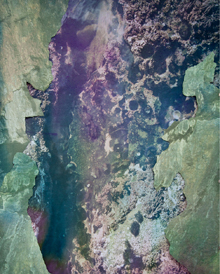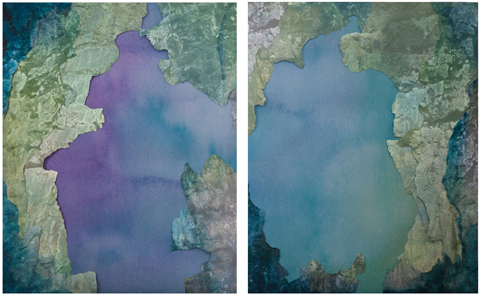
HANDSOME ABSTRACTION Ganz’s Tidal Pool II. |
Theresa Ganz, who teaches photography at Brown University, grew up in New York City. So her sense of nature, she writes, comes more from books and 19th-century German Romantic landscape painting than from getting muddy in the woods.In "Don't get out much," her exhibit at Brown University's Bell Gallery (64 College St, Providence, through October 7), she mulls this divide between direct experience of sticks and stones and the drama imbued in artistic representations of the great outdoors. Her past work includes cut out and collaged photos of tangled branches of trees and bushes; the early ones were composed as decorative patterns, but they've increasingly become all-over abstract patterns.
Here she collages together her photos (shot on film, converted to digital) of glacial rocks and the flora and fauna of tide pools with digital scans of loose watercolor washes. In Tidal Pool I (2012), we seem to be looking down through a ring of rocks into a milky ocean pool of snails and seaweed; Tidal Pool II (2012) similarly blends photos that together suggest an underwater canyon or green moon rocks. In Tidal Pool III (2012), we peer through a green and gray rocky canyon that frames a valley of pink underwater plants.
Ganz tints most everything green — like bronze that has oxidized due to exposure to the elements. This gives her photographic prints a vintagey patina, like the cover of an old sci-fi paperback or an image run through a nostalgic Instagram filter. The actual physical layering of the photographic prints plus the changing focus within these images give a feeling of rocky 3D spaces. You can get lost in the realist details — or read them as handsome, if rather polite, abstractions in the tradition of Aaron Siskind.

WATERCOLOR WASHES Ganz’s Cavern Diptych. |
In some, like Cavern Diptych or her Pass diptychs, the collaged on rock photos become frames around blue-green-purple watercolor washes. I think they're supposed to feel like pools or skies you could fall into, but her open watercolor fields jibe awkwardly with the highly detailed rock photos, flattening the space and making it feel inert.
Ganz's painting technique also hampers her ambitious 490-square-foot mural covering the floor-to-ceiling windows of the building's entrance lobby. She blows up blue-green-purple watercolor washes to vast proportions in an attempt "to put the viewer inside the space of the images." Her painting chops aren't compelling enough to be that transporting or command so much territory. But when weather conditions are right, the sun coming through the trees outside can project dramatic silhouettes of their trunks and branches onto the windows.
Another Brown teacher, Ed Osborn, a professor of sound art, computing, and electronic media, is showing his musical-mechanical contraptions in "Standing Wave" at the Wheeler School's Chazan Gallery (228 Angell St, Providence, through October 10). The installation consists of five metal poles, with speakers on top, slowly swaying in metal stands — picture robot sunflowers swaying in an acid breeze. Wires run from each one into an electronic box and eventually a Mac computer displaying a blue wave screensaver.